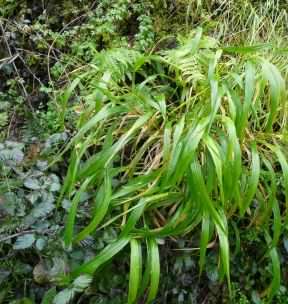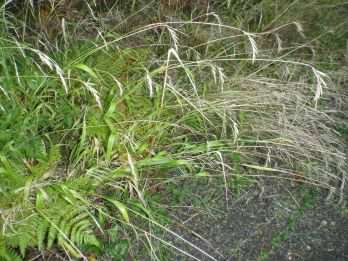
Photo ©2007 Pere prlpz
Click any photo for a larger image

Photo ©2014 Scot Loring

Photo ©2007 Pere prlpz
Click any photo for a larger image

Photo ©2014 Scot Loring
False–brome - Brachypodium sylvaticum
Family - Poaceae
Also known as - Wood False brome
A perennial grass native to the UK, Europe, Asia, Africa but classed as a dominating noxious invasive weed species in parts of America. It is a clump forming grass growing to around 0.9m (3ft) tall, and is commonly found in shaded woodlands, forests, scrub and riparian areas but it does not do well in persistent wet conditions. It has a growth pattern similar to a miniature Bamboo with clumps of thin woody stems and long lanceolate dark green to yellow green drooping leaves, 15mm (0.6in) wide by 80–100mm (3–4in) long which gradually narrow to a thin pointed tip. The leaf is edged with fine hairs and joined to the hollow stem (culm) by a clasping sheath. The leaves turn a pale brown to bleached white colour in the winter. Again, like Bamboo, False–brome is a fast–spreading invasive grass that is capable of displacing native plants forming dense, monotypic colonies.
An Inflorescence of drooping narrow long spikelets of flowers on very short pedicels. The flower head is 6–20 centimetres (2.4–7.9in) long with straight awns 6–18mm (0.24–0.71in) long, projecting out of the end of the spikelets. Usually seen from May to August. The False–brome is a food plant for several butterfly species including the Essex Skipper – Thymelicus lineola also found in Brickfields Park.
Site design ©1999– Brickfields Country Park - Privacy -